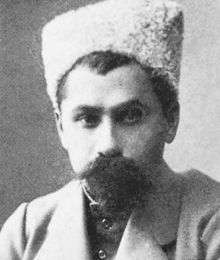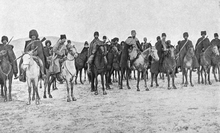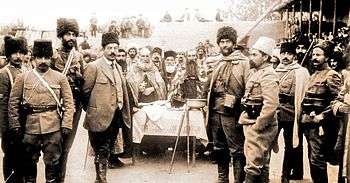Drastamat Kanayan
| Drastamat Kanayan Դրաստամատ Կանայեան | |
|---|---|
 | |
| Defense Minister of Armenia | |
|
In office 24 November 1920 – 2 December 1920 | |
| Preceded by | Ruben Ter-Minasian |
| Succeeded by | position abolished |
| Civil Commissioner of Van | |
|
In office December 1917 – 7 April 1918 | |
| Preceded by | position established |
| Succeeded by | position abolished |
| Personal details | |
| Born |
31 May 1884 Surmalinsky Uyezd, Erivan Governorate, Russian Empire |
| Died |
8 March 1956 (aged 71) Boston, Massachusetts, U.S. |
| Nationality | Armenian |
| Political party | Armenian Revolutionary Federation |
| Military service | |
| Nickname(s) | General Dro |
| Allegiance |
|
| Years of service |
1914—1920 1941—1945 |
| Commands |
2nd Battalion Volunteer Corps Armed Forces of Yerevan 812th Armenian Battalion |
| Battles/wars |
Armenian National Liberation Movement World War I Georgian-Armenian War Armenian-Azerbaijani War Turkish-Armenian War World War II |
Drastamat Kanayan (Armenian: Դրաստամատ Կանայեան; 31 May 1884 – 8 March 1956), better known as Dro (Դրօ), was an Armenian military commander and politician, a member of the Armenian Revolutionary Federation. He served as Defense Minister of Armenia in 1920, during the country's brief independence. During World War II, he led the Armenian Legion.[1]
Early life
Drastamat Kanayan was born in Surmali, Russian Empire (present-day Iğdır, Turkey) in 1884. He was the son of Martiros Kanayan, the head of the Kanayan clan in Igdir, and his wife, Horom. At an early age, Martiros enrolled his son to the parish school of Igdir. Drastamat would skip school to hang out near the military barracks of Igdir because of his interest in the military exercises held there. Igdir at the time was an important military post where between 8000 and 10000 Russian troops were stationed including infantry, Cossacks, cavalry and border guards. Most of the inhabitants of the village thrived by trading with the soldiers. Noticing that his son had no interest in books and learning, Martiros pulled him out of the village school and enrolled him to the Yerevan Gymnasium school.[2]
Drastamat was no better in the Gymnasium school as the grades he achieved were barely enough for a promotion. Like all government schools in the provinces of Russia, there was a policy of Russification that limited education in the Armenian language to religion only. Inspired by stories of General Andranik's triumphs in the Ottoman Empire and the spread of nationalism by the Armenian Revolutionary Federation, Drastamat joined a secret youth movement in his school that opposed the Czar's government and promoted Armenian nationalism.[3]
Edict on Armenian church property
On 12 June 1903, the tsarist authorities passed an edict to bring all Armenian Church property under imperial control. This was faced by strong Armenian opposition because it perceived the Tsarist edict as a threat to the Armenian national existence. As a result, the Armenian leadership decided to actively defend Armenian churches by dispatching militiamen who acted as guards and holding mass demonstrations.[4] This prompted Drastamat to join the ranks of the Dashnaktsutiun in order to defend churches from confiscation through public demonstrations and guard duty.[3]
World War I

He served as detachment commander in the Russian Caucasus Army during World War I. He was one of the commanders of the Armenian volunteer units and decorated by the Tsar.[5]

In November 1914, he had the second battalion of the Armenian volunteers. At the Bergmann Offensive, the second battalion of the Armenian volunteers engaged in battle for the first time, near Bayazid. In the course of a bloody combat which lasted twenty-four hours, Dro, commander of the battalion, was seriously wounded. From that day to March of the following year, he remained in critical condition, but his battalion led into eleven battles in the neighborhood of Alashkert, Toutakh, and Malashkert, until Dro recovered and returned to resume the command. Kanayan had already become a popular military leader after the victories over the Ottoman Empire at the Caucasus Campaign.
Between March 1918 and April 1918 he was appointed by the Armenian National Council military commissar to the occupation of Turkish Armenia of the Ararat region. He was the commander of the Armenian forces in the Battle of Bash Abaran.[2]
First Republic of Armenia

From 24 November to 2 December 1920, Kanayan was the Defence Minister of the short-lived First Republic of Armenia and commanded Armenian troops in various successful wars. The last battles against the Ottoman Empire at the Caucasus Campaign essentially saved the Armenian Republic from total destruction. As a Defence Minister before the end of 1918, he took responsibility at the Armenian-Azerbaijani war 1918 and Georgian-Armenian War 1918. Later in 1920, Turkish-Armenian War. In 1920, after the establishment of the Soviet regime in Armenia, Drastamat Kanayan remained in the country. He was exiled with 1,200 officers of the Republican army in January 1921; he later went to Moscow, finally settling in Romania in 1925.[2]
Armenian-Azerbaijani war
In 1920, Drastamat Kanayan advanced to the vicinity of Shushi.[6] On the night from 21–22 March 1920, when the Azerbaijanis were celebrating Novruz Bayram, the Armenians of Karabakh revolted and organized a surprise attack.[7] During these clashes thousands of people from both the Armenian and Azerbaijani sides were killed, with more than 7,000 houses burned, with Shusha virtually cleansed of its Armenian population.
In April 1920, the Bolshevik leadership of the Red Army informed from the Drastamat Kanayan to leave Karabagh. Karabagh-Zangezur was on the break of armed confrontation between Armenia and Azerbaijan, and Drastamat Kanayan knew that if he did not compy with this demand the Red Army and the armed forces of Azerbaijan would have to act jointly.[8]
He was forced to withdraw due to the Sovietization of Azerbaijan and the assurances given by the emissaries of Sergo Ordzhonikidze regarding a just solution to the Karabagh conflict.[6] On 26 May 1920, the 10th Congress of the Armenian National Council of Karabagh, which took place in Taghavard village, proclaimed the change of position. The "Armenian National Council of Karabagh" was replaced with the The Revolutionary Committee of Nagorno Karabagh, headed by S. Hambartsumian. That same day, Kanayan along with his units was forced to leave Karabagh.[8]
World War II
During Stalin's Red Terror, many Armenians were murdered or imprisoned. During World War II, the Dashnaks saw a good opportunity in free themselves from Stalin and create an Armenian nation in a post-World War II world dominated by the Axis powers.
On 8 February 1942, they formed a Legion of 11 battalions from those Armenians, who were prisoners in the Nazi POW camps and had opted to fight for German forces rather than face the genocidal conditions of those camps. The Legion was 18,000-strong and had been known as Armenische Legion, while the 812th Armenian Battalion of Wehrmacht as each battalion of this unit, had 1,000 men under the command of Kanayan. The Legion was trained by Wehrmacht officers and participated in the occupation of the Crimean Peninsula and the Caucasus.[9]
According to Joris Versteeg, the total number of Armenians serving in the German armed forces during the war was 18,000: 11,000 were placed in field battalions, while 7,000 were placed in logistic and non-combat units. Ailsby puts the number at 11,600. After World War II, Kanayan emigrated to the United States and continued his political activities with the purpose of advancing the Armenian Cause. In 1947, at the World Congress of the A.R.F., he was forgiven for his collaboration with Nazis, as he could justify it with powerful arguments, and was again elected a member of the Party.[10]
Death, burial, and legacy
.jpg)
With the end of World War II, Drastamat Kanayan was arrested by American forces, but soon released. Kanayan settled within the large Armenian Diaspora of Lebanon. When traveling to the U.S. for medical treatment, he died in Boston on 8 March 1956. His remains were taken to Armenia for final burial in Aparan, on 28 May 2000, within the commemoration of the 82nd anniversary of the First Republic of Armenia.[11]
The government of Armenia founded the General Dro National Institute of Strategic Studies, and the Ministry of Defense established a medal in his name to decorate military personnel and civilians who excelled in military teaching.[12]
Gallery
- Dro's mausoleum in Aparan, Armenia
 Dro's mausoleum at night
Dro's mausoleum at night- Dro's grave in Mount Auburn Cemetery, Watertown, Massachusetts (pre-reinterment in Armenia)
 Dro's bust in Gyumri
Dro's bust in Gyumri General Dro
General Dro
Sources
- Dimensions of Democracy and Authority in Caucasian Armenia, 1917-1920, Richard G. Hovannisian, Russian Review, Vol. 33, No. 1 (January 1974)
References
- ↑ Thomas de Waal. Great Catastrophe: Armenians and Turks in the Shadow of Genocide. Oxford University Press, 2015, p. 112
- 1 2 3 Chelebian, Antranig (2009). Dro (Drastamat Kanayan) : Armenia's first defense minister of the modern era. Los Angeles, CA: Indo-European Pub. ISBN 1604440783.
- 1 2 Vratsian, Simon (2000). Tempest-Born DRO. Armenian Prelacy, New York, translated by Tamar Der-Ohannesian. pp. 13–22.
- ↑ Geifman, Anna. Thou Shalt Kill: Revolutionary Terrorism in Russia, 1894-1917. pp. 21–22. ISBN 0-691-02549-5.
- ↑ Smbat Minasyan. "HISTORY OF ARTSAKH". Retrieved 16 January 2007.
- 1 2 Richard G. Hovannisian, "Historical Memory and Armenian-Azerbaijani Relations", The Armenian Perspective, 14 September 2000
- ↑ Richard G. Hovannisian. The Republic of Armenia, Vol. III: From London to Sèvres, February–August 1920, ISBN 978-0520088030
- 1 2 Government source. "HISTORY OF ARTSAKH". Ministry of Foreign Affairs NKR, 2001. Retrieved 16 January 2007.
- ↑ The banality of denial: Israel and the Armenian genocide, Yair Auron, p. 238, ISBN 978-0765808349
- ↑ Drastamat Kanayan profile, membres.lycos.fr/armenianlegion
- ↑ "General Dro Reburied in Armenia". Armenian International Magazine. June 2000. p. 26.
- ↑ "Birth of Tro (May 31, 1884)". Milwaukee Armenian Community. 1 June 2013. Retrieved 19 September 2014.